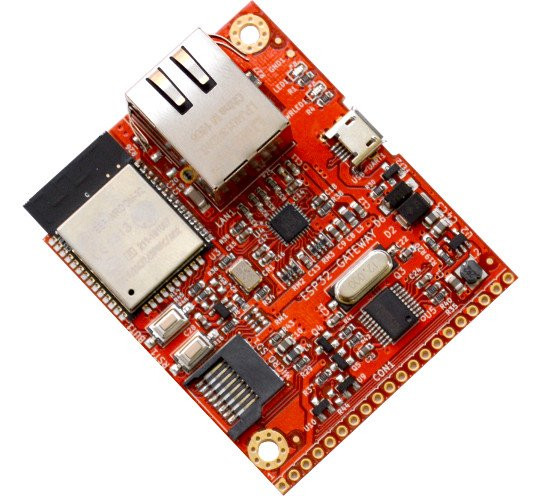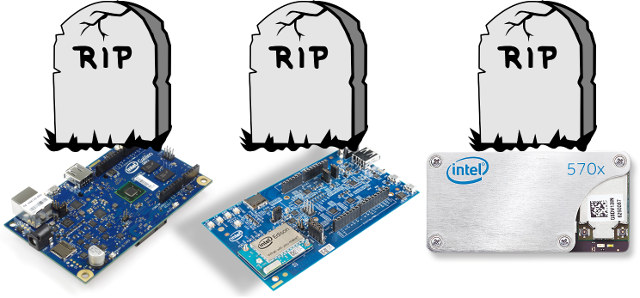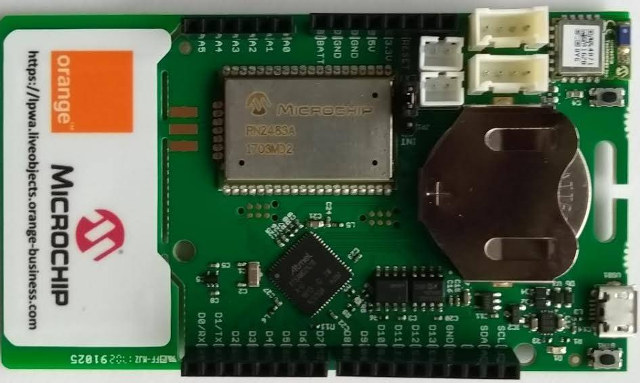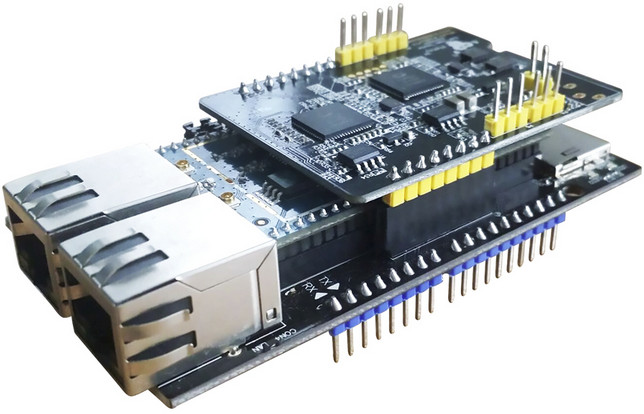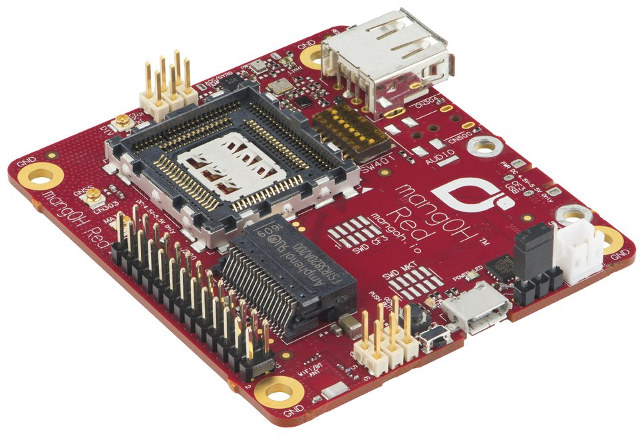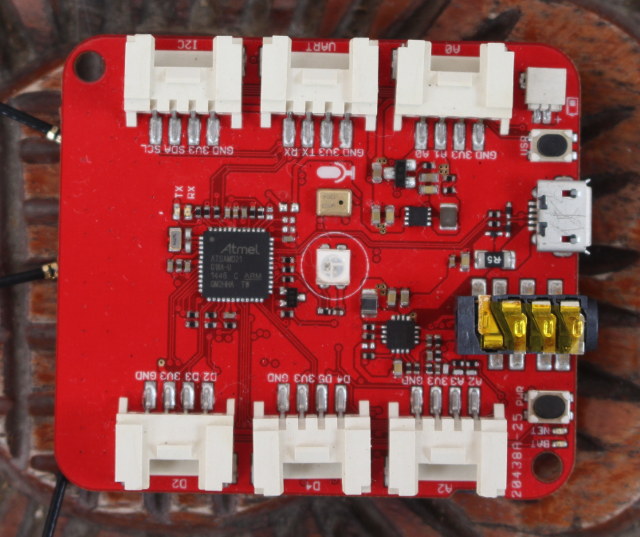Olimex has just launched ESP32-GATEWAY board, as cost-down version of their ESP32-EVB board, still with Ethernet, WiFi, and Bleutooth LE, but without any relays, CAN bus, nor IR control, less I/Os, and a smaller footprint. Olimex ESP32-GATEWAY specifications: Wireless Module – ESP32-WROOM32 module with 802.11 b/g/n WiFi and Bluetooth LE Wired Connectivity – 10/100M Ethernet with RJ45 jack (via LAN8710A) External Storage – micro SD slot Expansion – 20-pin GPIO connector USB – 1x micro USB port for debugging (CH340T) and power Misc – Reset and user buttons Power Supply – 5V via micro USB port Dimensions – 62 x 50 mm Another change is the lack of a LiPo charger to run the board from batteries. Just like most Olimex boards, ESP32-GATEWAY is open source hardware with KiCAD design files available on Github. The software directory is still empty, but Ethernet demo code using ESP32-IDF has been pushed for […]
Intel Issues End-of-Life Notices for Galileo / Galileo 2, Edison and Joule Boards & Modules
While I’m not sure many of my readers are using them, Intel introduced several IoT development kits and modules over the years, with products like Intel Galileo, followed by Galileo 2, Edison module development board all based on Quark processors, and more recently Intel Joule modules powered by Intel Atom T550x / T570x processors. The three boards / modules and corresponding modules will soon be no more, as Intel issues three end-of-life (EOL) notices for: Intel Galileo Board, and Intel Galileo Gen2 Board Products – PDF Select Intel Edison Compute Module, Intel Edison Breakout Board, Intel Edison Kit for Arduino, and Intel Edison Breakout Board Kit Products – PDF Intel Joule 570x Compute Module, Intel Joule 550x Compute Module, Intel Joule 570x Developer Kit and, Intel Joule 550x Developer Kit Products – PDF All three follow the same “forecasted key milestones”: June 16, 2017 – Product Discontinuance Program Support Begins […]
Microchip based Orange LoRa Explorer Kit Connects to Orange’s own LoRaWAN Network
You’d think Telecom operators with all infrastructure in place would focus their IoT efforts on LTE Cat M1 or LTE Cat NB-IoT, but Orange has setup its own LoRa network in France with the aim of achieving national coverage by December 2017, at which time they’ll also test interconnection and roaming with other European operators. The company has also launched the LoRa Explorer Kit based on Microchip solutions, and designed by SODAQ. Orange LoRa Explorer Kit specifications: MCU – Microchip Atmel SAMD21 ARM Cortex M0+ MCU @ 48 MHz with 256KB flash, 32KB RAM, up to 16KB EEPROM by emulation Storage – 4Mbit serial flash (Microchip SST25PF040C) Connectivity Microchip RN2483A LoRa module + PCB antenna Microchip RN4871 Bluetooth 4.2 module (BLE) with ceramic antenna Security – Microchip ATECC508A1 crypto chip to securely store LoRa keys. USB – 1x micro USB port for charging and programming Expansion – “Arduino M0” compatible headers with 10-bit […]
Design Amazon Alexa Gateways, Robots and Smart Speakers with WisCore Modular Development Kit
RAK Wireless has launched a new development board powered by Mediatek MT7628A processor running OpenWrt with built-in WiFi and Ethernet connectivity, and audio codec and microphone to support Amazon Alexa voice service. Bluetooth, Zigbee, and Z-wave will also be supported via UART modules. Wiscore Specifications: Processor – Mediatek MT7628A MIPS24KEc CPU @ up to 580MHz System Memory – 128MB DDR2 (64 MB optional) Storage – 16 MB flash + micro SD card Audio MicroSemi ZL38062 for audio in and out MicroSemi ZL38067 to handle “Alexa” keyword single or dual digital microphone up to 5 meter range Far field voice wake up Support for echo cancellation Connectivity 802.11 b/g/n WiFi 2×2 MIMO up to 300 Mbps 2x 10/100M Ethernet (LAN and WAN) Optional UART modules for Bluetooth, ZigBeem Z-Wave USB – 1x USB 2.0 host port Expansion – Arduino headers with UART, I2C, SPI and GPIOs Power Supply – 5V via […]
MangOH Red Open Source Hardware Board Targets Cellular Industrial IoT Applications
Sierra Wireless has announced MangOH Red open source hardware platform designed for IIoT (Industrial IoT) applications with a snap-in socket for 2G to 4G & LTE-M/NB-IoT modules, built-in WiFi and Bluetooth, various sensors, a 26-pin expansion header, and more. MangOH Red board specifications: Snap-in socket to add any CF3-compatible modules, most of which based on Qualcomm MDM9215 ARM Cortex A5 processor including: Airprime WP7502 LTE Cat 3, HSPA, WCDMA, EDGE/GPRS module Airprime WP7504 LTE Cat 3, HSPA, WCDMA, CDMA module Airprime WP7601 LTE Cat 4 module Airprime WP7603 LTE Cat 4, WCDMA module Airprime WP8548 HSPA, WCDMA, EDGE/GPRS, and GNSS module AirPrime HL6528RD quad-band GSM/GPRS Embedded Wireless Module designed for the automotive market And more…. Storage – micro SD slot Wireless MCU Module – Wi-Fi 802.11 b/g/n and Bluetooth 4.2 BLE module with an ARM Cortex-M4 core MCU (Mediatek MT7697) providing access to real-time I/Os Wireless Connectivity “Accessories” Micro SIM card […]
Review of Wio Tracker with GPS, Bluetooth 3.0 and GSM Connectivity
Wio GPS – also called Wio Tracker – is an Arduino compatible board based on Microchip Atmel SAMD21 MCU with GPS, Bluetooth, GSM/GPRS connectivity, as well as several Grove connectors to connect sensors and modules for your IoT project. SeeedStudio sent me a sample for evaluation, so I’ve tested it, and reported my experience below by testing some of the Arduino sketches. Wio Tracker Unboxing All I got in the package was Wio GPS tracker v1.1 board. The top includes the Atmel MCU, an RGB LED, a microphone and 3.5mm AUX jack to make phone calls, a user and power button, a micro USB port for power and programming, a small 2-pin connector for a battery, and 6 Grove connectors for digital, serial, I2C and analog modules. The other side of the board comes with Quectel MC20 module that handles Bluetooth, GPS and GSM, a dual use micro SD card […]
Apple Opens HomeKit Accessory Protocol Specification to Non-Commercial Projects
HomeKit is a software framework that allows Apple users to control smart devices with their iPhone or iPad. But so far, you had to become an MFI licensee to design a HomeKit compatible device, you product had to be tested by Apple, and – according to a story on Hackster.io – also required a special cryptographic chip for authentication. Developers creating commercial devices still need to become an MFI license, but Apple has now opened HomeKit Accessory Protocol Specification for non-commercial projects, meaning you can now use the Framework on Arduino, ESP8266 boards, Raspberry Pi, and other development boards using software authentication. You could already use HomeKit on Raspberry Pi board previously using HomeBridge, but the advantage now is that you don’t need to breach Apple’s terms and conditions, and you can talk directly to your phone without the need for a bridge. If you want the specifications got to […]
Amazon AWS Greengrass Brings Local Compute, Messaging, Data Caching & Sync to ARM & x86 Devices
Amazon Web Services (AWS) provides cloud computing services to manage & store data from IoT Nodes over the Internet, but in some cases latency may be an issue, and Internet connectivity may not be reliable in all locations. AWS Greengrass provides a solution to those issues by running some of the IoT tasks within the local network in ARM or x86 edge gateways running Linux. You can still manage your devices from AWS cloud, but a Linux gateway running Greengrass Core runtime will be able to run AWS Lambda functions to perform tasks locally, keep device data in sync, and communicate with devices running AWS IoT Device SDK. Greengrass benefits include: Response to Local Events in Near Real-time Offline operation – Connected devices can operate with intermittent connectivity to the cloud, and synchronizes with AWS IoT once it is restored Secure Communication – AWS Greengrass authenticates and encrypts device data […]


